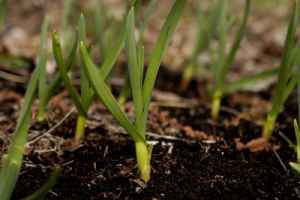Doug Oster

The key to a good garden is good compost, and every gardener worth his salt should be making his own.
Compost is a wonderful thing, plants are happy when grown in this sweet black soil amendment. Making your own is easy. Anything that once was living will eventually become compost. The trick is how fast you can harvest it.
How to Compost
The first thing to do in setting up a composting system is deciding where the fresh material will go. In my garden I've got three compost bins made of pallets, which I nailed together. Each bin holds about 3 cubic yards, and although they've lasted 10 years, it's time to rebuild. I'll find some free pallets and put them together.
As you won't be able to move the bins once they're full, think carefully where you put them in the first place. I made a mistake with my first layout. The garden is surrounded by a picket fence and the bins are only a couple feet on the other side of it. I'm going to fix that when I rebuild.
The three bins form a system.
I fill up the first one, then start filling the second and then the third. By the time the second bin is filled, the first is ready to harvest. It takes about a year.
Now, if I wanted that compost quicker I could turn the material over. Every time that's done it will decompose about 50 percent quicker. But I'm too lazy, so I wait.
But what goes in the bin? Well everything left over in the kitchen except meats, oils or dairy. It's not that they won't compost; they sometimes attract rodents, which can be a problem.
What to Compost
In the kitchen, the material earmarked for composting includes unbleached paper towels, fruit and vegetable trimmings, peals, rinds, coffee grounds, eggshells and more.
Out of the garden, any plant material is fair game for composting as long as it's disease free. The smaller the material is when added, the faster it will break down. Shredding dry material with a lawn mower is a great way to speed decomposition.
First timers are always surprised at how much can be recycled to the compost pile.
There are two basic types of material for the compost, green and brown.
The green stuff is anything soft, like plants and kitchen scraps. The brown is paper products and dried leaves.
For best results they should be layered when you make the pile at a 50/50 ratio by volume. That being said, I never worry about ratios and I get good compost; it just might take a while.
One of the hardest things is getting everybody on board in the house to split the waste stream. The family has to learn what goes to the compost and what is sent to the trash. Having a bucket with a lid that closes in the kitchen works well and can be taken out to the bin every couple days.
If the pile starts to smell like three-day-old melon rinds, it means it's too wet. Just get in there with a garden fork and loosen things up, and in a day or two you won't smell a thing.
I like to leave a small depression at the top of my pile to catch water in the summer.
The compost is ready to harvest when it's fine, black and sweet smelling.
How to use Compost
There are many ways to use the finished compost.
I have a sieve made out of hardware cloth and 2-by-4s. I lay it over the wheelbarrow when I'm shoveling the compost, and bigger items like corn cobs don't make it through and are thrown into the next bin, to decompose for one more year. I've found all sorts of things in the bin -- lots of forks, for some reason.
To give plants everything they need for the season, just add compost to the planting holes. Building raised beds with compost, too, will provide a nutrient rich environment for plants. Add just an inch of compost as mulch to give plants all the nutrients they need for the year.
If the bed is constructed the year before, it doesn't need to be turned over, and you can plant right in the soft compost. This allows us to plant earlier during a wet spring.
Some crops, such as garlic, can be planted in the fall and will thrive come spring. Then you can harvest the greens and make delicious dishes such as the one that follows, a great way to inaugurate the season of eating out of the garden.
AUTOS | HOBBIES | EDUCATION | FAMILY | FASHION | FOOD & RECIPES | HOME DECOR | RELATIONSHIPS | PARENTING | PETS | TRAVEL | WOMEN
Composting From Garden to Kitchen to Garden
Home & Garden - Gardening
© Tribune Media Services